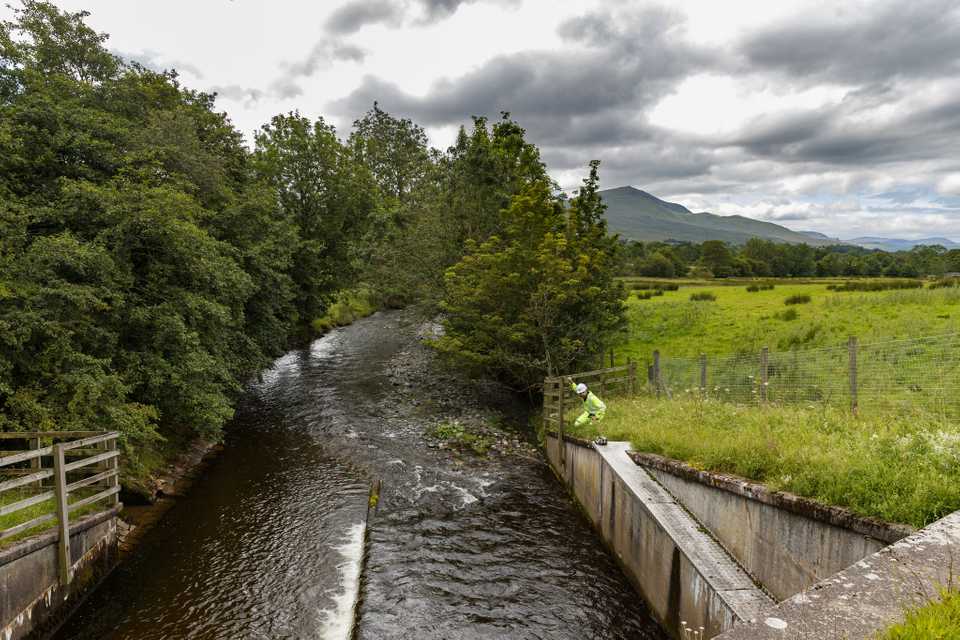Table of Contents
PEI Report Chapter 14 : Click Here
PEI Report Figures : Click Here
PEI Report Appendices : Click Here
Glossary and Abbreviations : Click Here

This section summarises the preliminary assessment findings at this point in the EIA process for road drainage and the water environment, based on PEI Report Chapter 14: Road Drainage and the Water Environment, which considers the potential effects on the quality and quantity of surface and ground waters, geomorphology and flood risk that may result from construction activities and operational road drainage.
Baseline
The water environment comprises the road drainage system, surface water features, groundwater resources and flood risk within the study area. The links between the surface water, groundwater and flood risk creates a very complex environmental setting.
The land within the M6 junction 40 to Kemplay Bank, Penrith to Temple Sowerby, Temple Sowerby to Appleby and Appleby to Brough schemes drain into the River Eden via a number of main rivers and ordinary watercourses of varying value.
The Bowes Bypass, Cross Lanes to Rokeby, Stephen Bank to Carkin Moor and A1(M) junction 53 Scotch Corner schemes drain into the River Greta and then the River Tees, via a number of main rivers and ordinary watercourses of varying value.
There are areas at risk of flooding across the schemes, most significantly within the M6 junction 40 to Kemplay Bank, Temple Sowerby to Appleby, and Appleby to Brough scheme study areas.
The underlying geology of the M6 junction 40 to Kemplay Bank, Penrith to Temple Sowerby, Temple Sowerby to Appleby and Appleby to Brough schemes is Penrith Sandstone, which transitions over to Carboniferous Limestones at Appleby to Brough and underlies the Bowes Bypass, Cross Lanes to Rokeby, Stephen Bank to Carkin Moor and A1(M) junction 53 Scotch Corner schemes. The Temple Sowerby to Appleby study area includes gypsum (a rapidly dissolving mineral compound) beds, which are significant for groundwater interactions. Limestone karst features are also present within the study area of Bowes Bypass. Springs, abstractions, and discharges are present across the schemes, and all dwellings downstream from the schemes have been assumed to use groundwater abstraction as a precautionary approach.
Construction
During construction, there would be the potential for adverse impacts on the quality and flow of surface water receptors. This is due to major earthworks near to watercourses and a changing of surface water flow routes. Physical changes to the watercourses and longer-term changes associated with sediment deposition has the potential to impact the hydro-morphological and ecological quality of surface waters.
Impacts to groundwater levels, flows and quality arising from construction activities, primarily dewatering, earthworks and intrusive investigation works creating new flow paths for groundwater, have the potential to occur.
Flood risk may be affected during the construction phase as a result of construction works and temporary storage areas within a floodplain that may temporarily affect the floodplain function, resulting in an increase in flood risk at that location or elsewhere.
There are established construction practice guidelines to manage pollution risks during construction. It is assumed that the Environment Agency’s Pollution Prevention Guidelines and Guidelines for Pollution Prevention will be adhered to in conjunction with a surface water management plan. Environmental monitoring of the water environment would also be undertaken throughout construction.
Preliminary construction assessment
- No likely significant effects are anticipated on the basis that the project construction design and EMP will incorporate the recommendations for mitigation that will be based on detailed modelling where relevant.
Operation
During operation, there is the potential for permanent impacts to the hydro-morphological and ecological quality of surface water receptors caused by the introduction of barriers that may alter natural processes. This potential impact is most relevant at Temple Sowerby to Appleby and Appleby to Brough. Mitigation will be embedded into the design of the crossings following detailed geomorphological modelling.
The rates and volumes of surface water runoff have the potential to change due to the increase in impermeable area or changes to the existing drainage regime, and additional crossings and infrastructure in the flood plain leading to a potential increase in flood risk to the project and to surrounding areas.
Without mitigation, operation of the road could lead to pollution impacts on surface water and groundwater from road run-off. Road drainage for the schemes is being developed to protect the water environment from highway pollution and to prevent increases in flood risk. A sustainable drainage system will be developed that would discharge into a series of road drainage attenuation basins to provide treatment before allowing water to gradually soak into the ground or flow into a watercourse. This approach would control pollution from road run-off to higher standards than for the current road.
There is the potential for increased dissolution of gypsum from road drainage in the Kirkby Thore area of the Temple Sowerby to Appleby scheme where gypsum is present, leading to potential ground instability. Mitigation will be embedded into the design, including any attenuation ponds and drainage in this area being fully lined to minimise any increase in infiltration.
There may also be a change in the rate of recharge of aquifers due to change in ground surface cover and introduction of new drainage systems, and a reduced dilution and/or dispersion of consented discharges to groundwater and treated sewage effluent due to reduced or redirected groundwater flow paths.
Preliminary operation assessment
- No likely significant effects are anticipated on the basis that the project design will incorporate the recommendations for mitigation that will be based on detailed modelling where relevant.